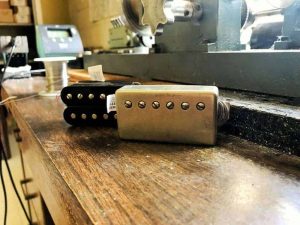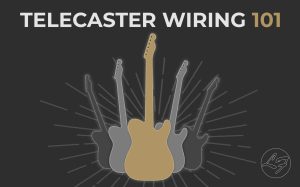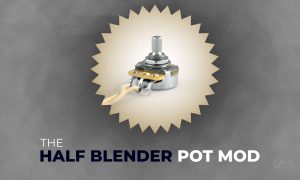
Understanding D.C. Resistance For Guitar Pickups
D.C. Resistance, or a pickup’s Ohm reading, is not the “Holy Grail” of understanding a pickup’s output – it will give you a rough understanding.
On occasion, we get a customer’s email stating that “their 8.2K Pure P.A.F. bridge reads 8K – What’s Wrong?” The answer is simply “Nothing at all.” There are a lot of variables that can make the same pickup provide different readings. However, there are more important things to take note of – at Fralin Pickups, we count turns rather than rely on ohm readings. Let’s learn a little bit about Ohm readings and what they mean for your guitar’s pickups:
Why Are Ohm Readings Important?
An Ohm reading shows the D.C. resistance of pushing electrical current through the pickup. It does not define the output of the pickup. The output of the pickup is affected by the number of turns of wire, and the magnet strength.
Ohm readings are a useful way of roughly measuring the output between identical pickup designs. This means comparing a Telecaster Bridge to another Telecaster Bridge, or a Stratocaster Neck to another Stratocaster Neck. For example, if you were to take a reading of a Vintage Hot Strat Neck (6K) and compare it to a Blues Special Strat Neck (6.3K), you’ll be able to confidently tell that the Blues Special will give you more output. This is true – the Blues Special has 5% more turns than the Vintage Hot, and roughly 5% more output.
The same applies to Humbuckers, which are normally measured by their ohm readings. A 9K humbucker will be higher output and louder than an 8K.
Ohm Readings tell you if a pickup works or not. If you test a pickup and get a reading, there is continuity in the coil – it works. If you get a reading of 0 Ohms, the pickup is shorted out. If the meter reads “Infinity”, the coil is broken somewhere and your pickup will not work.
Ohm readings can help diagnose problems. When we rewind pickups, we might get an old Strat pickup that has a reading of 50K, when it should read around 6K. We can use that information to tell that there’s corrosion in the coil eating away at the copper, giving it a point of high resistance. This coil would need to be re-wound to be fixed.
Ohm Reading Variations:
There are a few factors that can cause an ohm reading to fluctuate. Here are some of the most common:
- Temperature: The hotter the pickup is, the higher the ohm reading will be. When we test a pickup when it goes into the wax vs. when it comes out of the wax all hot, the ohm readings are vastly different. Why? As the temperature increases, the ions in the copper wire vibrate more than they do at room temperature, thus collide more with electrons as they flow through the copper wire, giving the wire more resistance.
- Length of Wire: See above! The longer the wire is (i.e. more turns per coil), the higher the resistance will be. This is how many users test guitar pickup output. Another example is a 5-String Jazz Bass versus a 4-String Jazz Bass. The 5-String Jazz bass is physically longer, and thus the same number of turns will result in very different ohm readings.
- Diameter of Wire: 42 Gauge Wire (larger diameter wire) will have less resistance than 43 Gauge Wire (smaller diameter wire). For instance, we wind Telecaster Bridges with 42 Gauge Wire, and the Telecaster Necks with 43 Gauge Wire (the bobbins are smaller). Even though the necks have less turns than the bridges, they have a higher ohm reading due to the smaller gauge wire. That does not mean that the neck pickup is louder than the bridge pickup – it just means it has more resistance.
- Testing Equipment: Depending on the manufacturer, quality, digital vs analog, etc. The way you test the ohm reading could have a significant impact on your reading.

COMMON MISTAKES WITH OHM READINGS:
The most common mistake we see people make when using Ohm readings is comparing two completely different pickup designs to each other. For instance, our Stock Pure P.A.F. set reads 7.8K in the Neck, and 8.2K in the Bridge. Our Blues Special Telecaster Neck also reads 7.8K – so they should be equal in output, right? Nope!
The design of the pickup and the amount of turns has the greatest effect on the pickup’s output and tone. For instance, the Humbucker might have two coils wired in series with 42 Gauge Wire, and the Telecaster Neck will have one tall, narrow coil with a 43-Gauge Wire. They might read the same, but their outputs and tone will be completely different.
OHM READING BRASS TACKS:
The number of turns is far more important than the Ohm reading of a pickup. If you got a Pure P.A.F. Neck that was reading 7.7K, rest assured that the correct amount of turns is on the pickup!
Always compare identical pickup designs. We can’t stress the word “Identical” enough – the slightest variation in design can really impact the ohm reading.
Call us when comparing different models. When comparing a Hum-Cancelling P-90 Neck to a Bridge Humbucker, we can narrow down the models that will work best. Call us. We’re here to help.
Comments
40 Comments For This Post
Leave A Comment
Want to chime in to the conversation? Please do so! Please respect others.







Hi, I hope you can help . I have a problem with my epiphone humbucker pick ups( I’m not getting any sound from the bridge or the kneck pickups. I have tested both pick ups for resistance and much to my suprise the bridge pickup reads 14.45 ohms and the kneck pickup reads 7.47 ohms can you explain what’s happening? Many thanks Jim.
Hey Jim, it’s very rare that both pickups fail together. Generally, one pickup will fail first. I’m thinking there is something downstream from your pickups that is causing the issue, like a bad switch or a bad output jack. The best way to figure this out is to test everything using a multimeter – follow the pickup’s signal to see where something is broken or failing.
Neck pickup went wonkie… died… ohms 254k. Gonna dig in and check for corrosion, ’96 strat. Have backup pickup, eh… ready to replace if unable to correct. ??
Hello Lindy and Team, I play a 2012 Fender pure vintage ’65 reissue Stratocaster.Neck and middle read 5.89 and 5.9 respectively.bridge-5.84k. I wanted to try a”slightly” hotter bridge.I luckily found a used Fralin Vintage Hot bridge pickup which fits the bill perfectly,only slightly hotter[6.54k].and well within the range of some old Strat pickups.Nice presence and clarity!Perfect bevel.Thanks for the fine sound and craftmanship. Gord Winnipeg,Canada.
Thank you so much for the information. I am doing a tele build atm and ordered 2 pick-ups. One had Alnico 5(?) Magnets and read 4.7k ohms, but it has a black cover.
I ordered a second pickup because it was $7 and had a chrome cover I could use for less than buying a new cover. And the ad said it was a “7.8k ohms”. My (same) multimeter read 4k ohms on the nose.
So very useful. Thank-you! I will keep you in mind for my future builds.
Thank you so much! Very helpful! Does it matter when having 2-diffrent ohms on a build? (Neck, bridge, wanna say 2-diffrent styles of pick-ups, bass) an bout pick-up ohm’s, to knobs, pots, switches? They’d be compatible? Say 10 ohm bridge, 2- 8 ohm neck, 25 pots, 20 switch? Hypethetically, #s not accurate…. Thank you so much! I’m a beginner w/ NO electrical experiences!!! As you can tell!
Hy,
About two years ago I bought a Di marzio 36th anniversary PAF: on the specification it is writtem that resistance should be 8,6 KOHm but my multimeter mesures 7,56. The pickup works. I installed with a different pickup at bridge, the latter mesuring the right value of K ohm. Both have the volume affected by turning the tone. What do you think? Best regards
Good info. As a 40+ year schooled electronics guy, this is good for those to understand overall “impedance” (D.C. resistance and basically any other variable affecting electron flow). An inductor is not like a passive resistor.